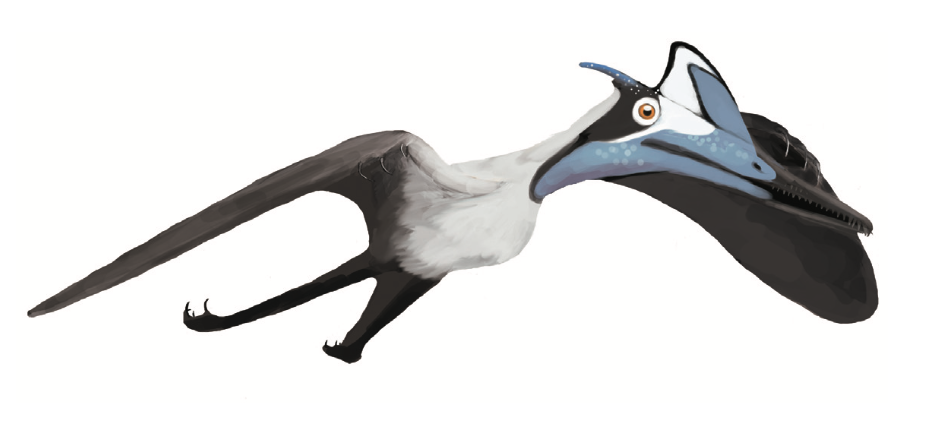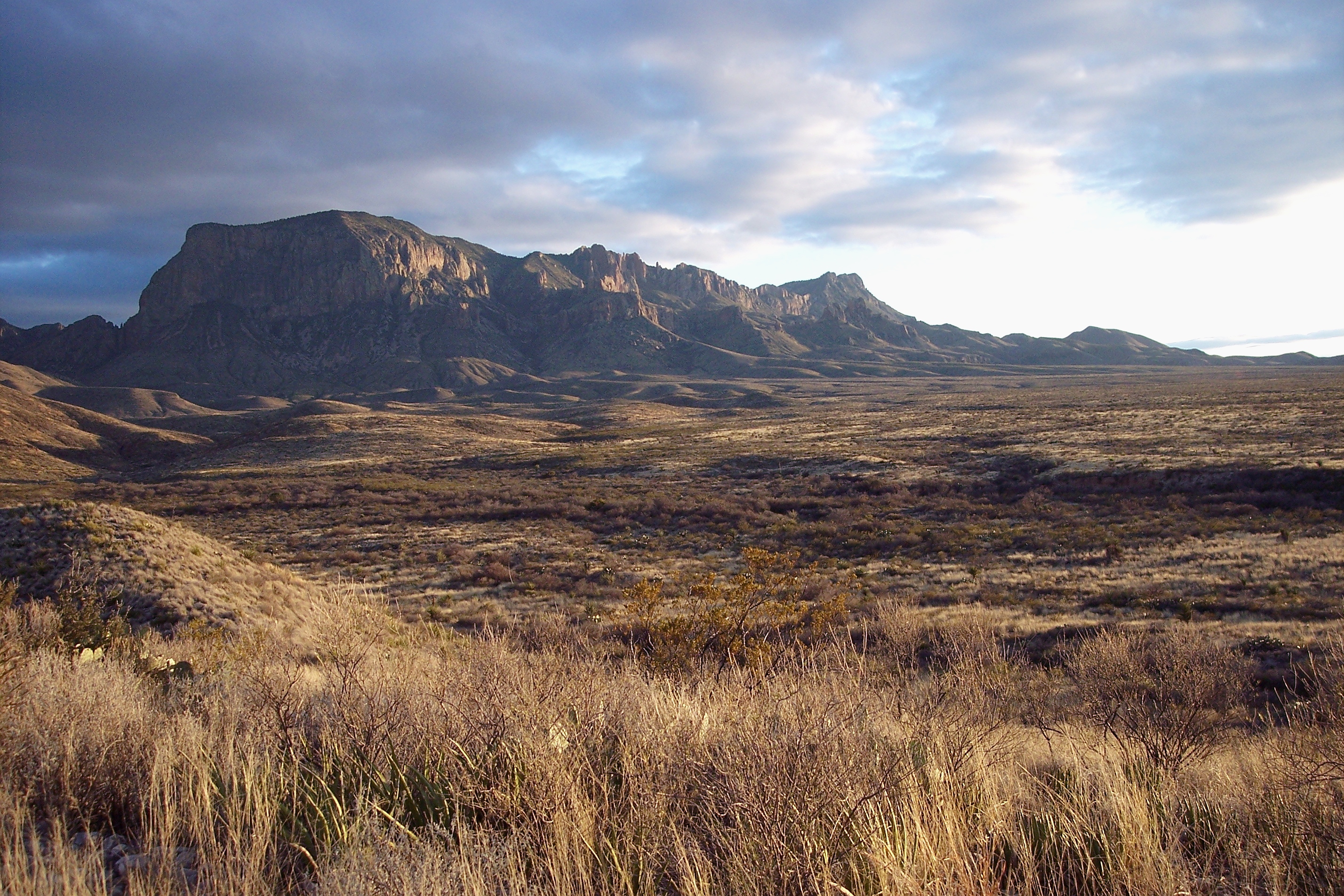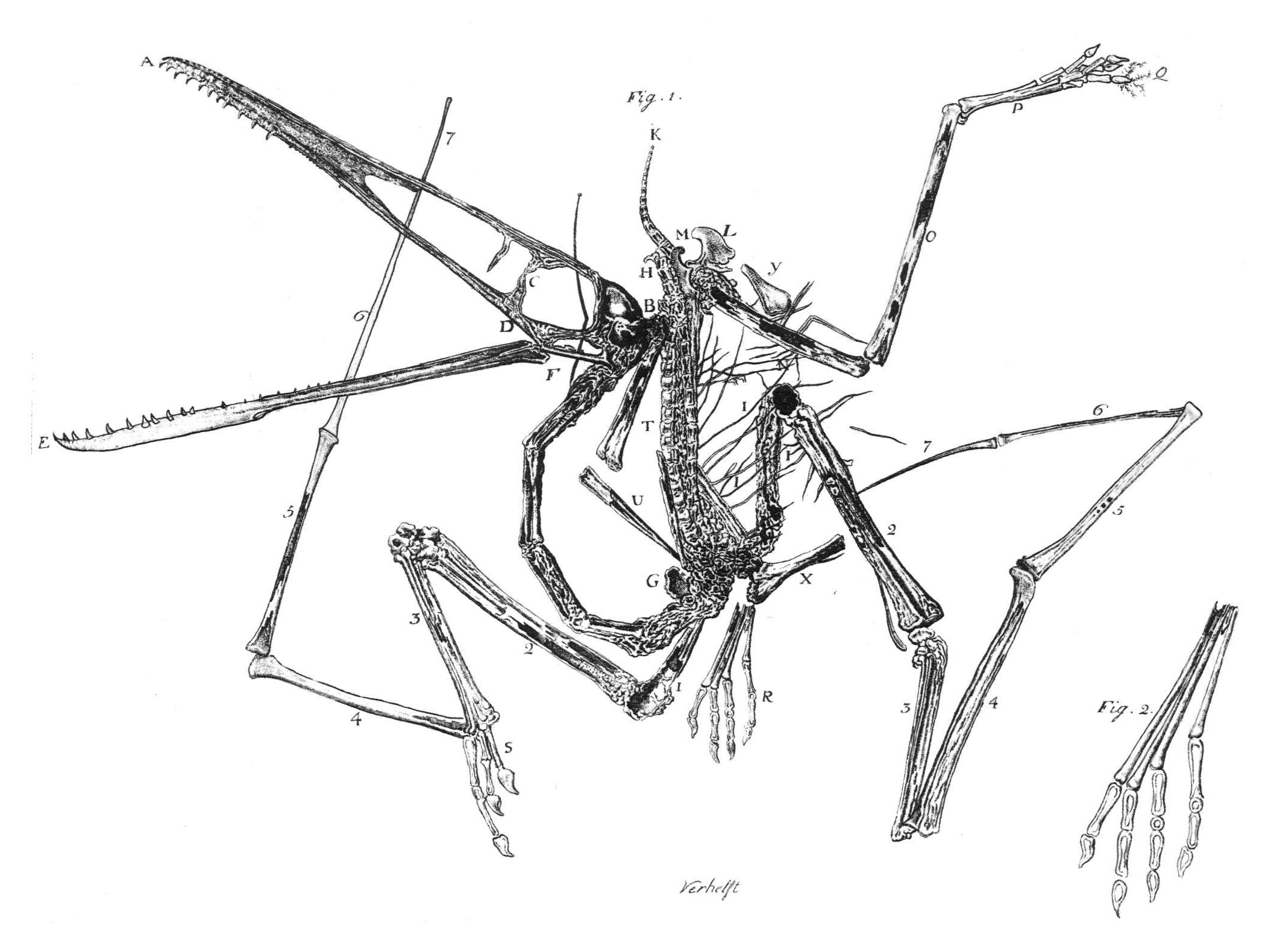|
Pterosaur
Pterosaurs are an extinct clade of flying reptiles in the order Pterosauria. They existed during most of the Mesozoic: from the Late Triassic to the end of the Cretaceous (228 million to 66 million years ago). Pterosaurs are the earliest vertebrates known to have evolved powered flight. Their wings were formed by a membrane of skin, muscle, and other tissues stretching from the ankles to a dramatically lengthened fourth finger. There were two major types of pterosaurs. Basal pterosaurs (also called 'non-pterodactyloid pterosaurs' or ' rhamphorhynchoids') were smaller animals with fully toothed jaws and, typically, long tails. Their wide wing membranes probably included and connected the hind legs. On the ground, they would have had an awkward sprawling posture, but the anatomy of their joints and strong claws would have made them effective climbers, and some may have even lived in trees. Basal pterosaurs were insectivores or predators of small vertebrates. Later pte ... [...More Info...] [...Related Items...] OR: [Wikipedia] [Google] [Baidu] [Amazon] |
Quetzalcoatlus
''Quetzalcoatlus'' () is a genus of azhdarchid pterosaur that lived during the Maastrichtian age of the Late Cretaceous in North America. The Type (biology), type specimen, recovered in 1971 from the Javelina Formation of Texas, United States, consists of several wing fragments and was species description, described as ''Quetzalcoatlus northropi'' in 1975 by Douglas A. Lawson, Douglas Lawson. The Generic name (biology), first part of the name refers to the Aztec serpent god of the sky, Quetzalcōātl, while the specific name, second part honors Jack Northrop, designer of a flying wing, tailless fixed-wing aircraft. The remains of a second species were found between 1972 and 1974, also by Lawson, around from the ''Q. northropi'' locality. In 2021, these remains were assigned to the name ''Quetzalcoatlus lawsoni'' by Brian Andres and (posthumously) Wann Langston Jr., Wann Langston Jr, as part of a series of publications on the genus. ''Quetzalcoatlus northropi'' has gained fame a ... [...More Info...] [...Related Items...] OR: [Wikipedia] [Google] [Baidu] [Amazon] |
Pterodactylus
''Pterodactylus'' (from ) is a genus of extinct pterosaurs. It is thought to contain only a single species, ''Pterodactylus antiquus'', which was the first pterosaur to be named and identified as a flying reptile and one of the first prehistoric reptiles to ever be discovered. Fossil remains of ''Pterodactylus'' have primarily been found in the Solnhofen limestone of Bavaria, Germany, which dates from the Late Jurassic period (Tithonian stage), about 150.8 to 148.5 million years ago. More fragmentary remains of ''Pterodactylus'' have tentatively been identified from elsewhere in Europe and in Africa. ''Pterodactylus'' was a generalist carnivore that probably fed on a variety of invertebrates and vertebrates. Like all pterosaurs, ''Pterodactylus'' had wings formed by a skin and muscle membrane stretching from its elongated fourth finger to its hind limbs. It was supported internally by collagen fibres and externally by keratinous ridges. ''Pterodactylus'' was a small pteros ... [...More Info...] [...Related Items...] OR: [Wikipedia] [Google] [Baidu] [Amazon] |
Eudimorphodon
''Eudimorphodon'' is an extinct genus of pterosaur that was discovered in 1973 by Mario Pandolfi in the town of Cene, Lombardy, Cene, Italy and described the same year by Rocco Zambelli. The nearly complete skeleton was retrieved from shale deposited during the Late Triassic (mid to late Norian stage,Wellnhofer, P. (1991). "Summary of Triassic Pterosaurs." ''The Illustrated Encyclopedia of Pterosaurs.'' London, UK: Salamander Books Limited. p. 67. . 219-215 million years ago),Müller R.T., Ezcurra M.D., Garcia M.S., Agnolín F.L., Stocker M.R., Novas F.E., Soares M.B., Kellner A.W.A. & Nesbitt S.J. (2023). ”New reptile shows dinosaurs and pterosaurs evolved among diverse precursors”. ''Nature'' 620(7974): p. 589–594. doi:10.1038/s41586-023-06359-z making ''Eudimorphodon'' one of the oldest pterosaurs known.Cranfield, I. ''The Illustrated Directory of Dinosaurs and Other Prehistoric Creatures''. London: Salamander Books, Ltd. Pp. 280–281. It had a wingspan of about . ''Eudim ... [...More Info...] [...Related Items...] OR: [Wikipedia] [Google] [Baidu] [Amazon] |
Campylognathoides
''Campylognathoides'' is an extinct genus of pterosaur discovered in the Württemberg Lias deposits (dated to the early Toarcian ageBarrett, P. M., Butler, R. J., Edwards, N. P., & Milner, A. R. (2008). "Pterosaur distribution in time and space: an atlas". ''Zitteliana'', 61–107/ref>) of Germany; this first specimen however, consisted only of wing fragments. Further better preserved specimens were found in the Holzmaden shale; based on these specimens, Felix Plieninger erected a new genus. Discovery In 1858 Friedrich August Quenstedt named a new species of ''Pterodactylus'': ''P. liasicus''. It was based on a fossil, holotype GPIT 9533, consisting of some wing bones, found on the Wittberg near Metzingen in layers dating from the early Toarcian, about 180 million years old. The specific name referred to the Lias. Quenstedt thought he had identified long metacarpals in the wing, concluding that the new species was therefore not belonging to more basal genera, like the long ... [...More Info...] [...Related Items...] OR: [Wikipedia] [Google] [Baidu] [Amazon] |
Tropeognathus
''Tropeognathus'' (meaning "keel jaw") is a genus of large pterosaurs from the late Early Cretaceous of South America. This genus is considered to be a member of the family Anhangueridae, however, several studies have also recovered it within another family called Ornithocheiridae. Both of these families are diverse groups of pterosaurs known for their keel-tipped snouts and large size. ''Tropeognathus'' is regarded as the largest pterosaur found in the Southern Hemisphere, only rivaled by the huge azhdarchids. The type and only species is ''Tropeognathus mesembrinus''. Fossil remains of ''Tropeognathus'' have been recovered from the Romualdo Formation, which is a Lagerstätte located in the Santana Group of the Araripe Basin in northeastern Brazil. Discovery and naming In the 1980s the German paleontology museum ''Bayerische Staatssammlung für Paläontologie und historische Geologie'' in Munich acquired a pterosaur skull from Brazilian fossil dealers that had probably been ... [...More Info...] [...Related Items...] OR: [Wikipedia] [Google] [Baidu] [Amazon] |
Dimorphodon
''Dimorphodon'' ( ) is a genus of medium-sized pterosaur from Europe during the early Jurassic Period (about 201-191 million years ago).Müller R.T., Ezcurra M.D., Garcia M.S., Agnolín F.L., Stocker M.R., Novas F.E., Soares M.B., Kellner A.W.A. & Nesbitt S.J. (2023). ”New reptile shows dinosaurs and pterosaurs evolved among diverse precursors”. ''Nature'' 620(7974): p. 589–594. doi:10.1038/s41586-023-06359-z It was named by paleontologist Richard Owen in 1859. ''Dimorphodon'' means "two-form tooth", derived from the Greek () meaning 'two', () meaning 'shape' and () meaning 'tooth', referring to the fact that it had two distinct types of teeth in its jaws – which is comparatively rare among reptiles. The diet of ''Dimorphodon'' has been questioned among researchers, with earlier interpretations depicting it as an insectivore or a piscivore. Recent studies have suggested that ''Dimorphodon'' likely hunted small vertebrates, though it still would have consumed soft inver ... [...More Info...] [...Related Items...] OR: [Wikipedia] [Google] [Baidu] [Amazon] |
Anurognathidae
Anurognathidae is a family of small, short-tailed pterosaurs that lived in Europe, Asia, and possibly North America during the Jurassic and Cretaceous periods. Eight genera are definitively known: '' Anurognathus'', from the Late Jurassic of Germany; '' Jeholopterus'', '' Luopterus'', '' Cascocauda'' and '' Sinomacrops'', from the Middle to Late Jurassic of China; '' Batrachognathus'', from the Late Jurassic of Kazakhstan; and '' Dendrorhynchoides'' and '' Vesperopterylus'', from the Early Cretaceous of China. Bennett (2007) suggested that the holotype of '' Mesadactylus'', BYU 2024, a synsacrum, belonged to an anurognathid, though this affinity has been questioned by other authors. ''Mesadactylus'' is from the Late Jurassic Morrison Formation of the United States. Indeterminate anurognathid remains have also been reported from the Middle Jurassic Bakhar Svita of Mongolia and the Early Cretaceous of North Korea. Anurognathids had wingspans of up to 900 mm. Classification A ... [...More Info...] [...Related Items...] OR: [Wikipedia] [Google] [Baidu] [Amazon] |
Peteinosaurus
''Peteinosaurus'' ( ; meaning "winged lizard") was a prehistoric genus of pterosaur. It lived in the late Triassic period in the late Norian age (about 218-215 million years ago),Müller R.T., Ezcurra M.D., Garcia M.S., Agnolín F.L., Stocker M.R., Novas F.E., Soares M.B., Kellner A.W.A. & Nesbitt S.J. (2023). ”New reptile shows dinosaurs and pterosaurs evolved among diverse precursors”. ''Nature'' 620(7974): p. 589–594. doi:10.1038/s41586-023-06359-z and at a wingspan of around , was one of the smallest and earliest pterosaurs, although other estimates suggest a wingspan of up to . Discovery Three fossils have been found near Cene, Italy. The first fossil, the holotype MCSNB 2886, is fragmentary and disarticulated. The second, the articulated paratype MCSNB 3359, lacks any diagnostic features of ''Peteinosaurus'' and thus might be a different species. This paratype has a long tail (20 cm) made more stiff by long extensions of the vertebrae; this feature is common a ... [...More Info...] [...Related Items...] OR: [Wikipedia] [Google] [Baidu] [Amazon] |
Preondactylus
''Preondactylus'' is a genus of long-tailed pterosaurs from the Late Triassic (Carnian-NorianPaul G.S. ''The Princeton Field Guide to Pterosaurs'' (Princeton University Press, 2022), p. 98 or late Norian,Barrett, P. M., Butler, R. J., Edwards, N. P., & Milner, A. R. (2008). Pterosaur distribution in time and space: an atlas. ''Zitteliana'', 61-107/ref> about 217-214 million years ago)Müller R.T., Ezcurra M.D., Garcia M.S., Agnolín F.L., Stocker M.R., Novas F.E., Soares M.B., Kellner A.W.A. & Nesbitt S.J. (2023). ”New reptile shows dinosaurs and pterosaurs evolved among diverse precursors”. ''Nature'' 620(7974): p. 589–594. doi:10.1038/s41586-023-06359-z that inhabited what is now Italy. It contains a single known species, ''Preondactylus buffarinii'', which was discovered by Nando Buffarini in 1982 at the Forni Dolostone near Udine in the Preone valley of the Italian Alps."Preondactylus." In: Cranfield, Ingrid (ed.). ''The Illustrated Directory of Dinosaurs and Other Prehis ... [...More Info...] [...Related Items...] OR: [Wikipedia] [Google] [Baidu] [Amazon] |
Anurognathus
''Anurognathus'' (from the Greek ''ανоυρα γναθος'' "frog jaw") is an extinct genus of small pterosaur from the Late Jurassic Altmühltal Formation of Germany. ''Anurognathus'' was first named and described by Ludwig Döderlein in 1923.Döderlein, L. (1923). "''Anurognathus Ammoni'', ein neuer Flugsaurier". ''Sitzungsberichte der Mathematisch-Naturwissenschaftlichen Abteilung der Bayerischen Akademie der Wissenschaften zu München'', 1923, 306-307. The type species is ''Anurognathus ammoni''. The specific name ''ammoni'' honours the Bavarian geologist Ludwig von Ammon, from whose collection Döderlein had acquired the fossil in 1922. Discovery The genus is based on holotype BSP 1922.I.42 ( Bayerische Staatssammlung für Palaeontologie und Geologie), found in the Solnhofen limestone near Eichstätt no later than 1922. It consists of a crushed, relatively complete skeleton on a slab. The counterslab is missing and with it most of the bones: much of the skeleton is on ... [...More Info...] [...Related Items...] OR: [Wikipedia] [Google] [Baidu] [Amazon] |
Eopterosauria
Eopterosauria is a proposed clade of basal pterosaurs from the Triassic. The term was first used in Andres ''et al.'' (2014) to include ''Preondactylus'', ''Austriadactylus'', ''Peteinosaurus'' and Eudimorphodontidae. Inside the group were two other new clades, Preondactylia, which included ''Preondactylus'' and ''Austriadactylus'', and Eudimorphodontoidea, to include Eudimorphodontidae and Raeticodactylidae. Eopterosauria was defined as "the least inclusive clade containing ''Preondactylus buffarinii'' and ''Eudimorphodon ranzii''". The specimen BSP 1994, previously assigned to ''Eudimorphodon ''Eudimorphodon'' is an extinct genus of pterosaur that was discovered in 1973 by Mario Pandolfi in the town of Cene, Lombardy, Cene, Italy and described the same year by Rocco Zambelli. The nearly complete skeleton was retrieved from shale depos ...'', was named the separate taxon '' Austriadraco'' in 2015, and assigned to the new family Austriadraconidae, but further classification ... [...More Info...] [...Related Items...] OR: [Wikipedia] [Google] [Baidu] [Amazon] |
Bergamodactylus
''Bergamodactylus'' is a putative genus of basal pterosaur which lived during the Late Triassic (early Norian) in the area of present-day Bergamo province in Italy. Its only species is ''Bergamodactylus wildi''. It was named in 2015 based on a pterosaur specimen which had previously been regarded as a juvenile ''Eudimorphodon'' or as identical to ''Carniadactylus''. Some Triassic pterosaur specialists consider the distinguishing features of ''Bergamodactylus'' to be invalid or insufficient to distinguish it from ''Carniadactylus'', and thus retain the specimen in that genus. History In 1978, Rupert Wild described a small pterosaur specimen in the collection of the ''Museo di Paleontologia dell´Università di Milano'', found near Cene, Lombardy. He referred to it as the "Milan Exemplar" and identified it as a juvenile of ''Eudimorphodon, Eudimorphodon ranzii''. Wild noted considerable differences with the latter's type specimen but these were explained as reflecting the young ... [...More Info...] [...Related Items...] OR: [Wikipedia] [Google] [Baidu] [Amazon] |










